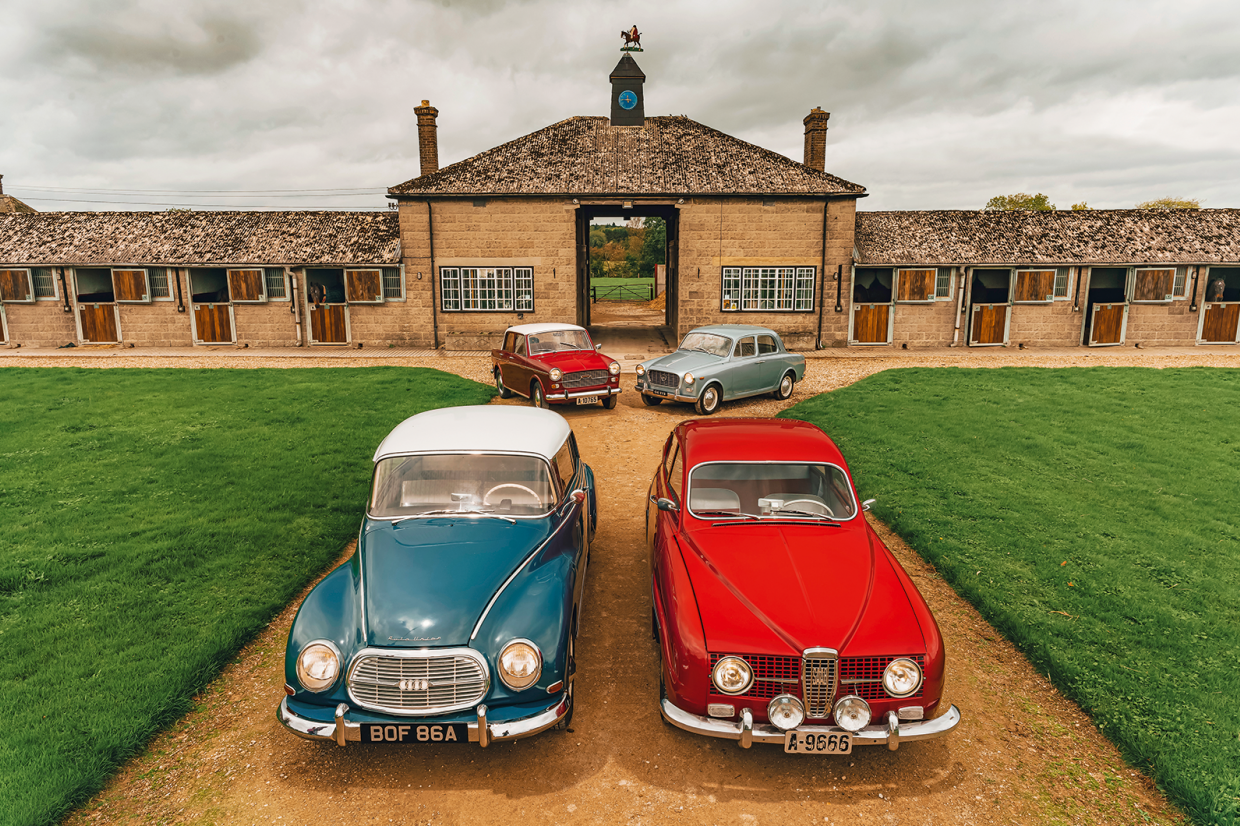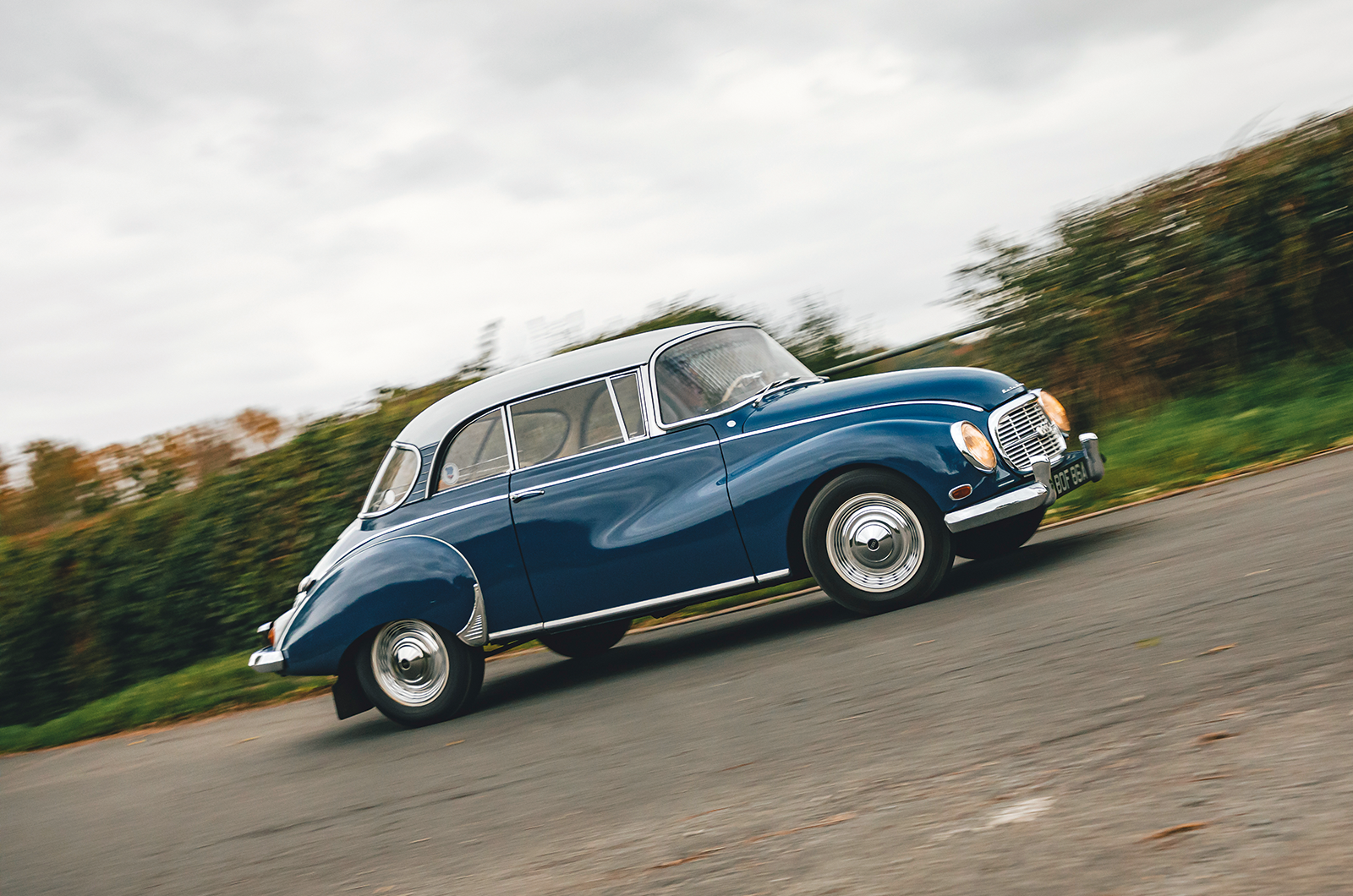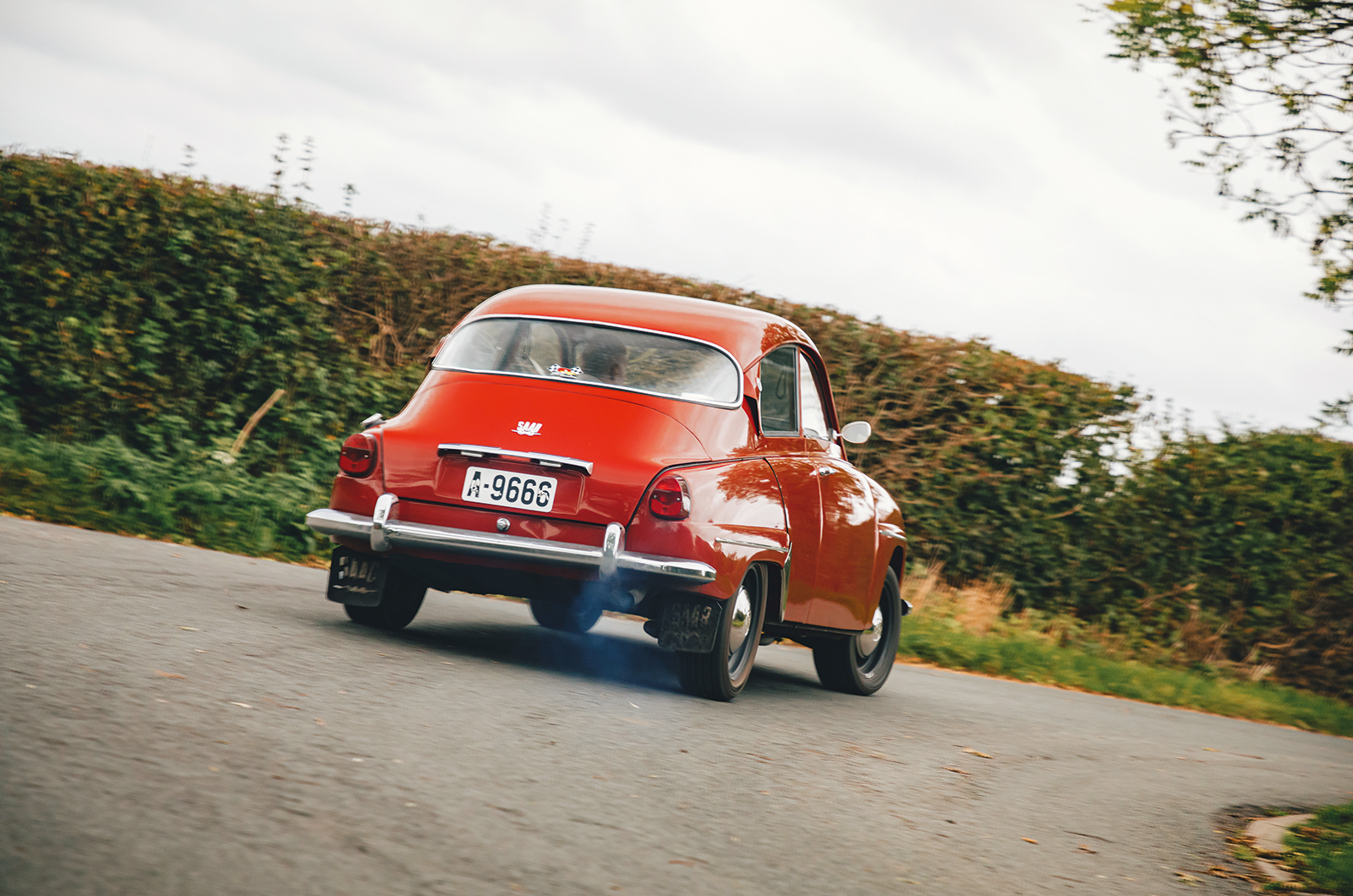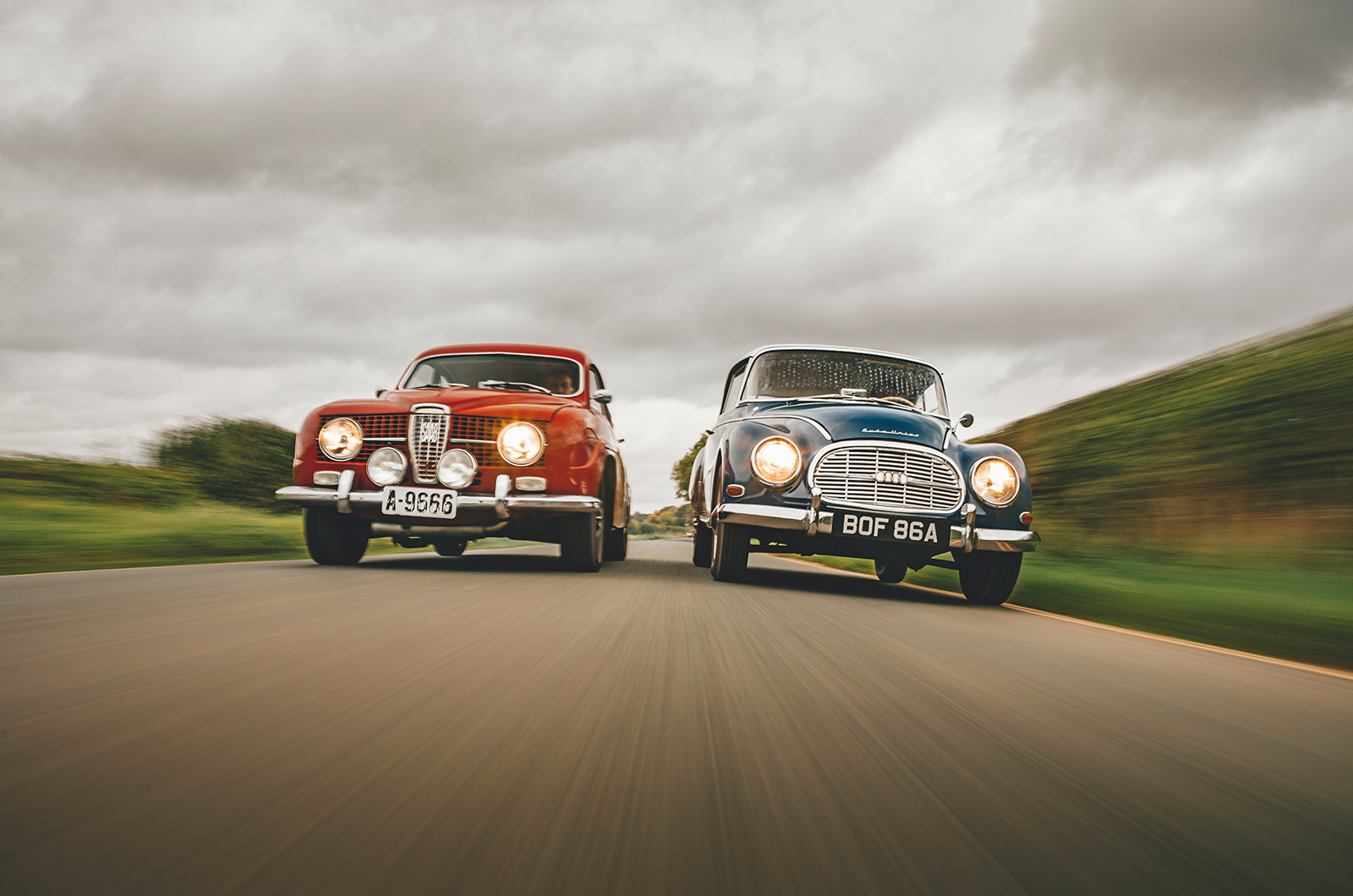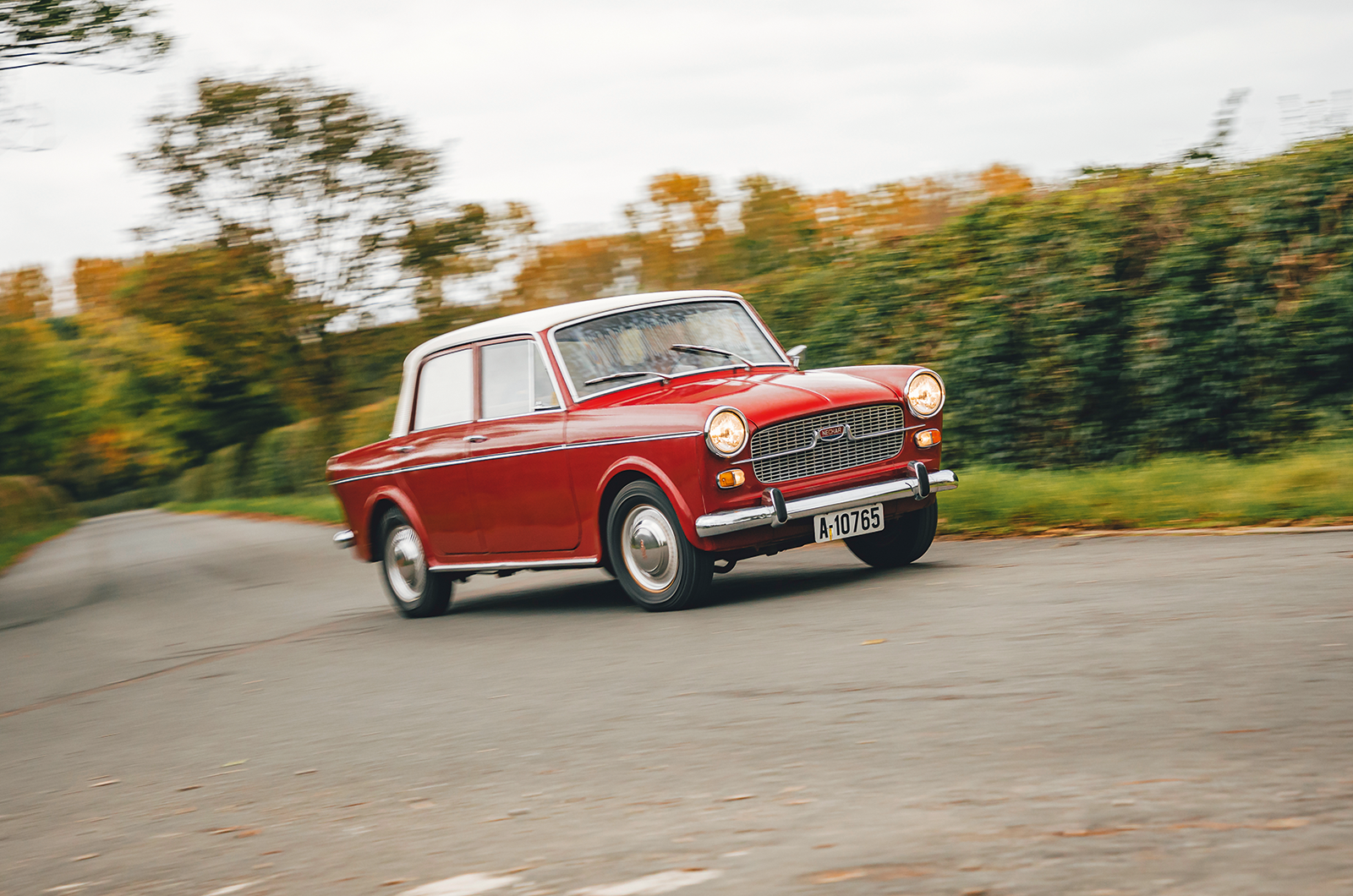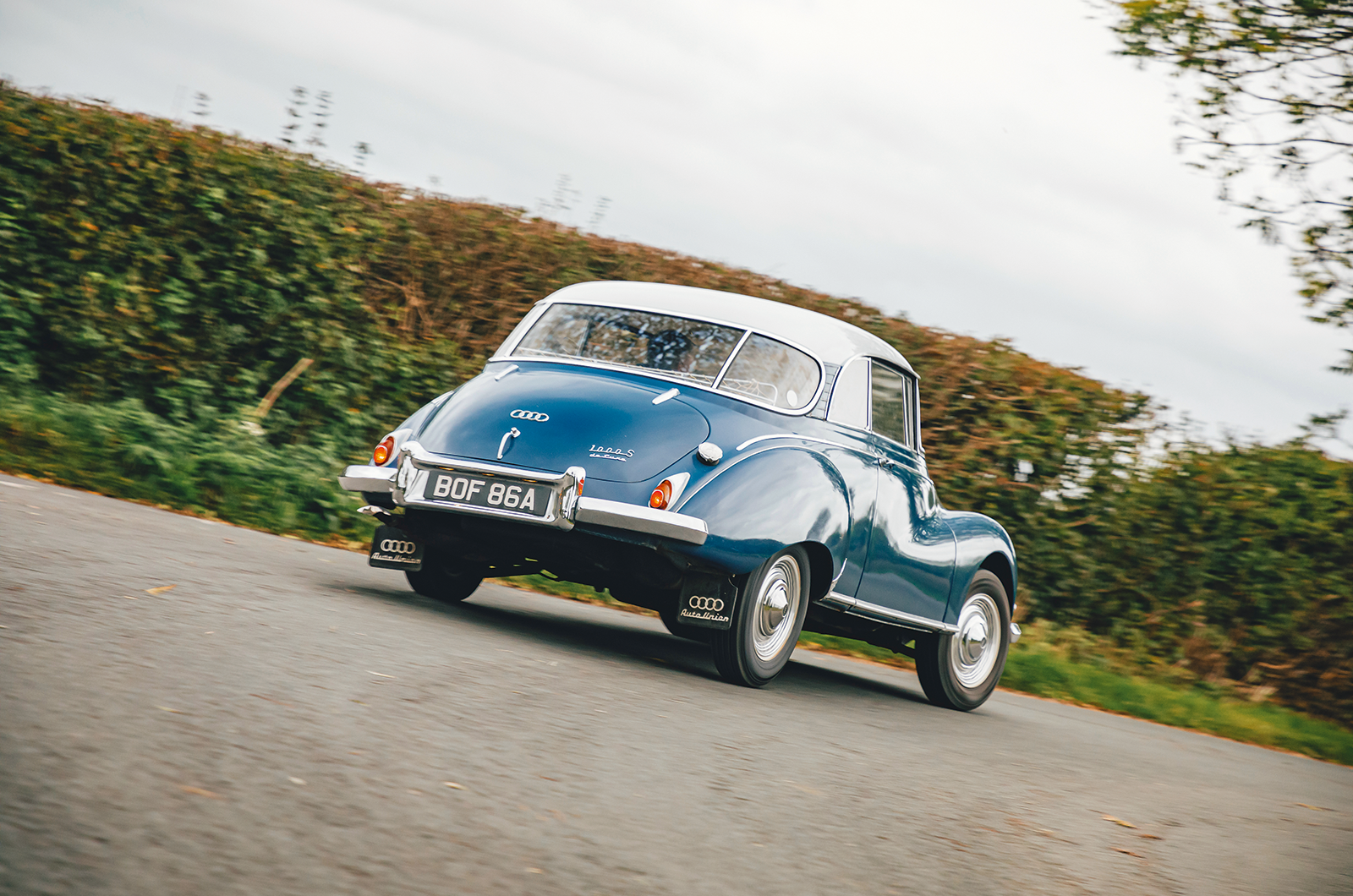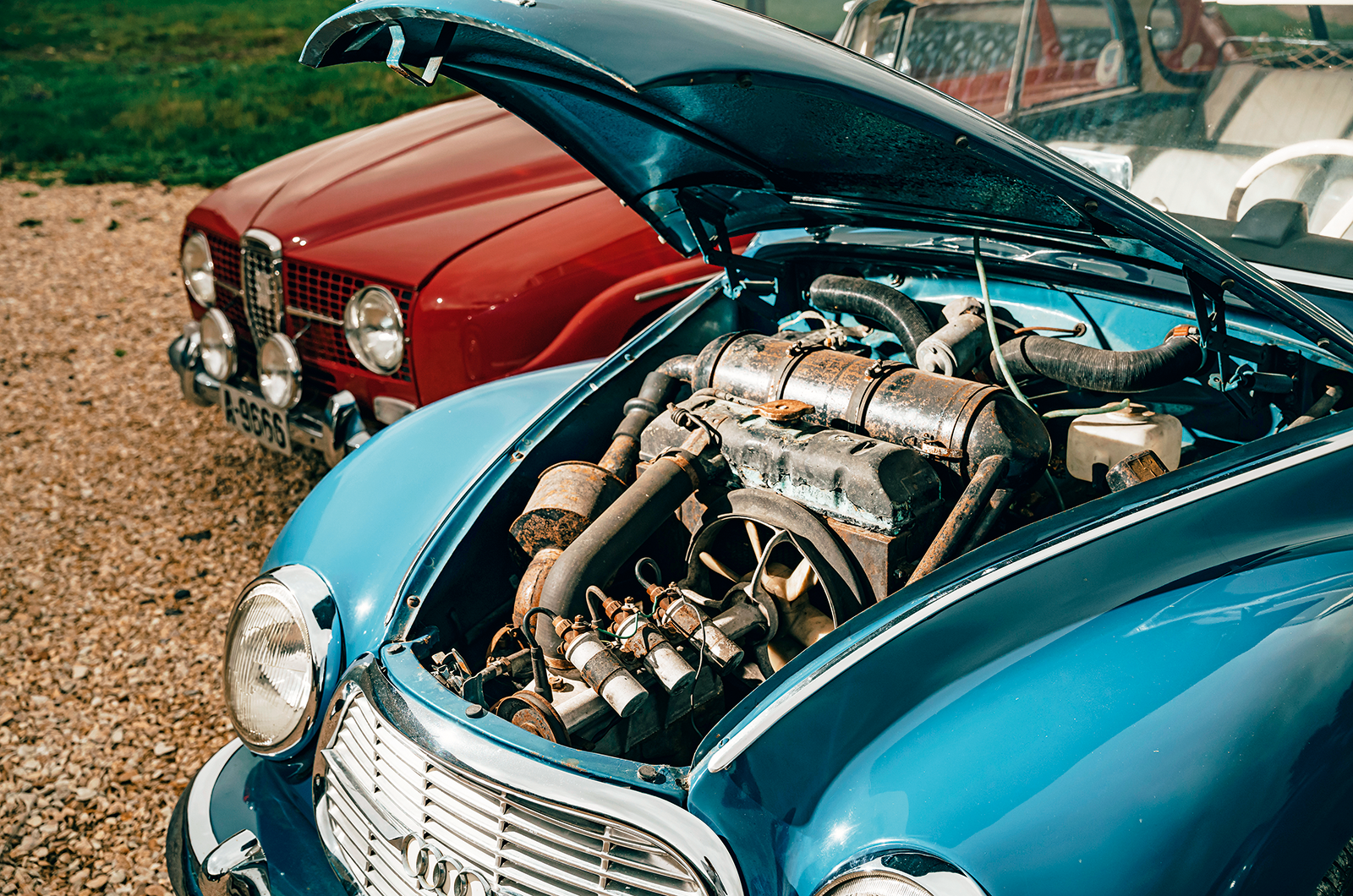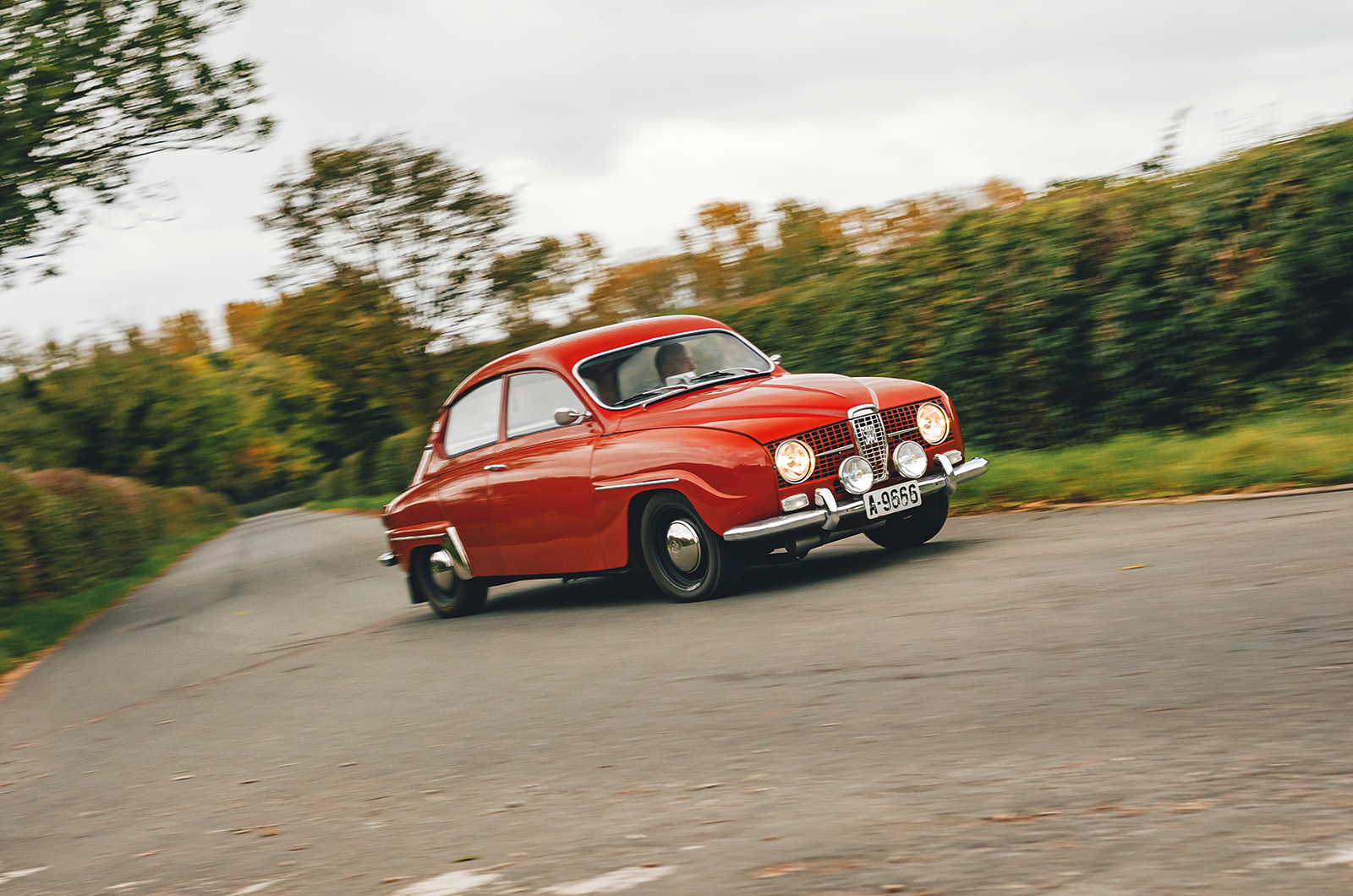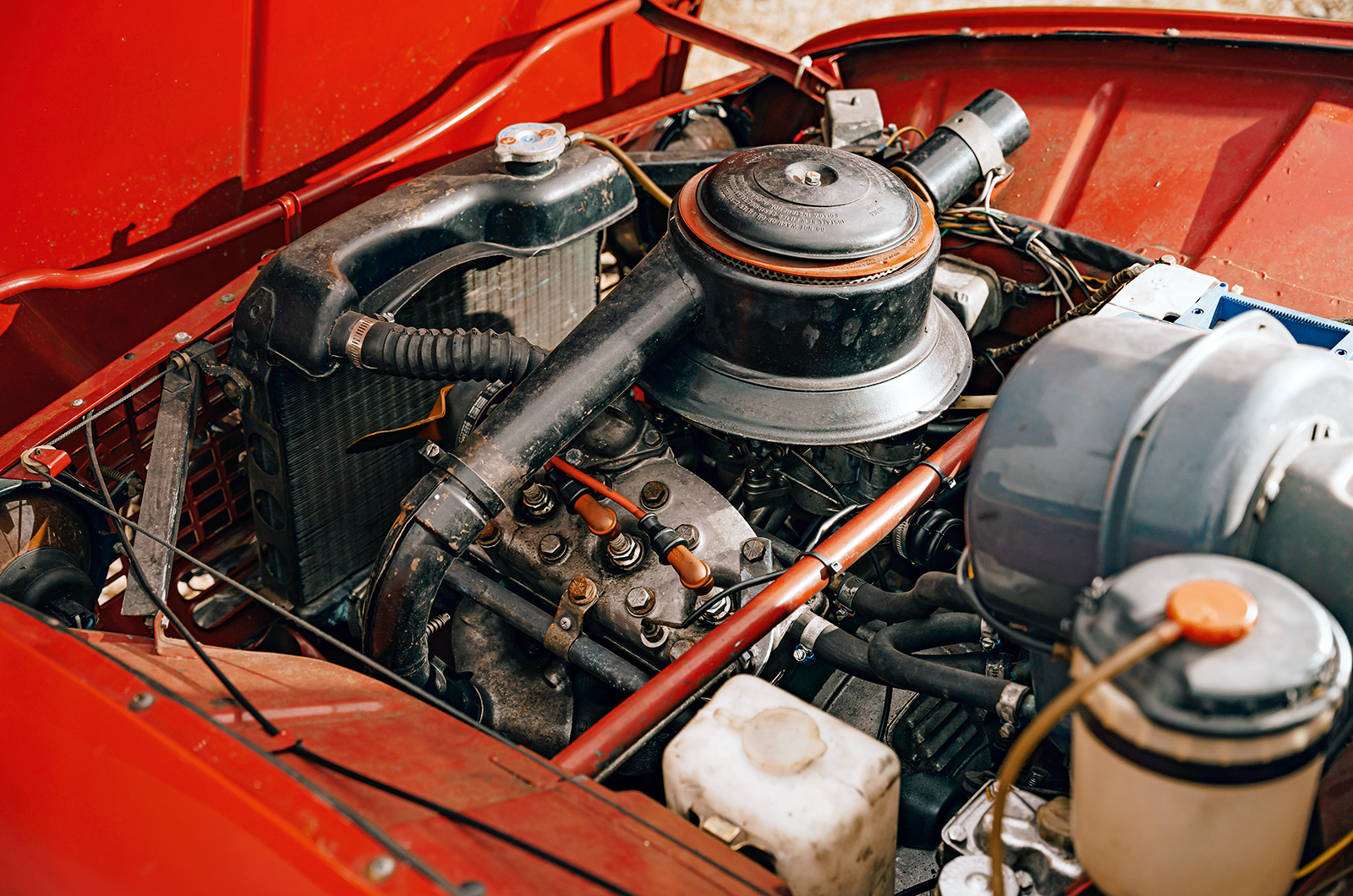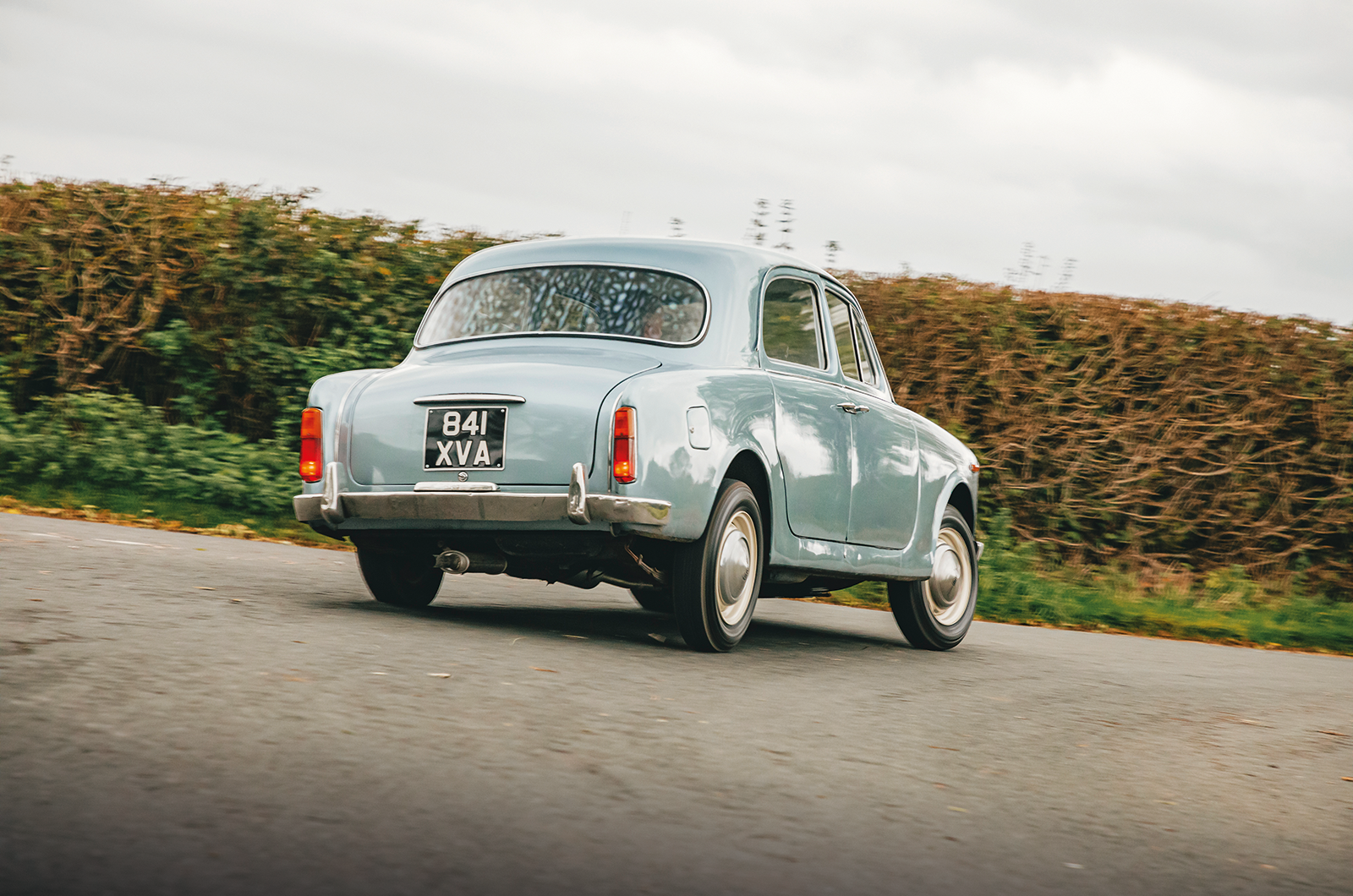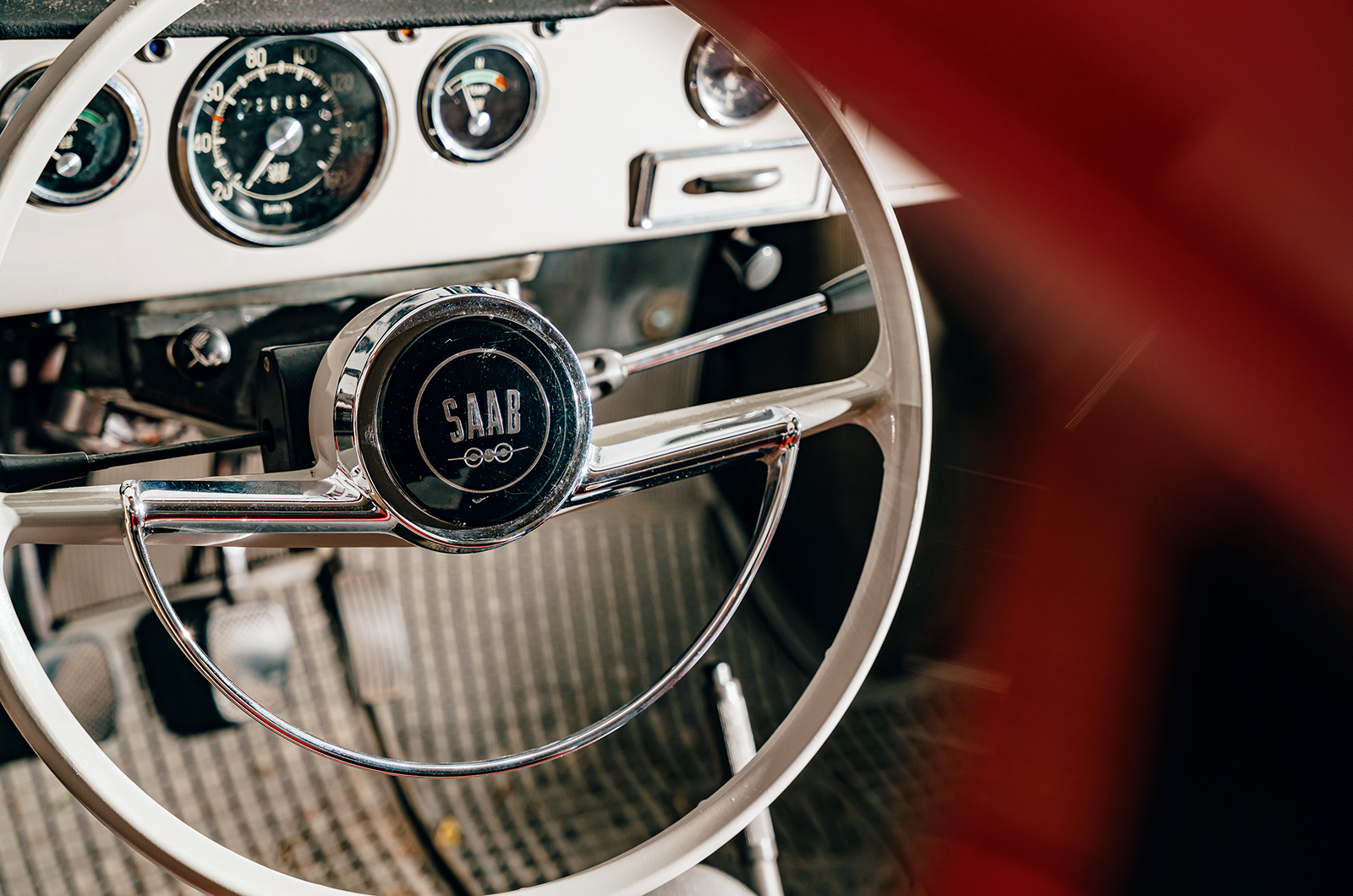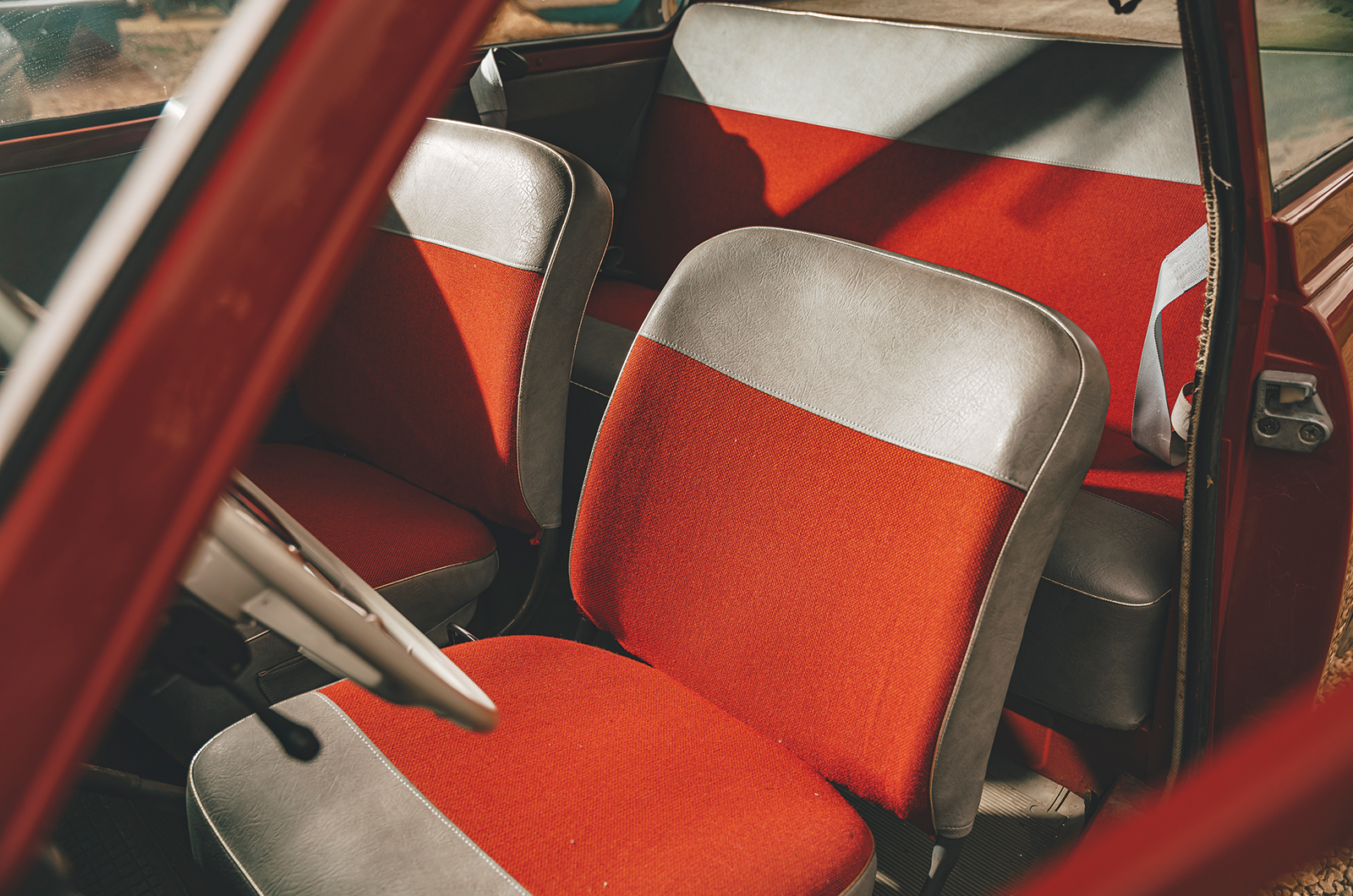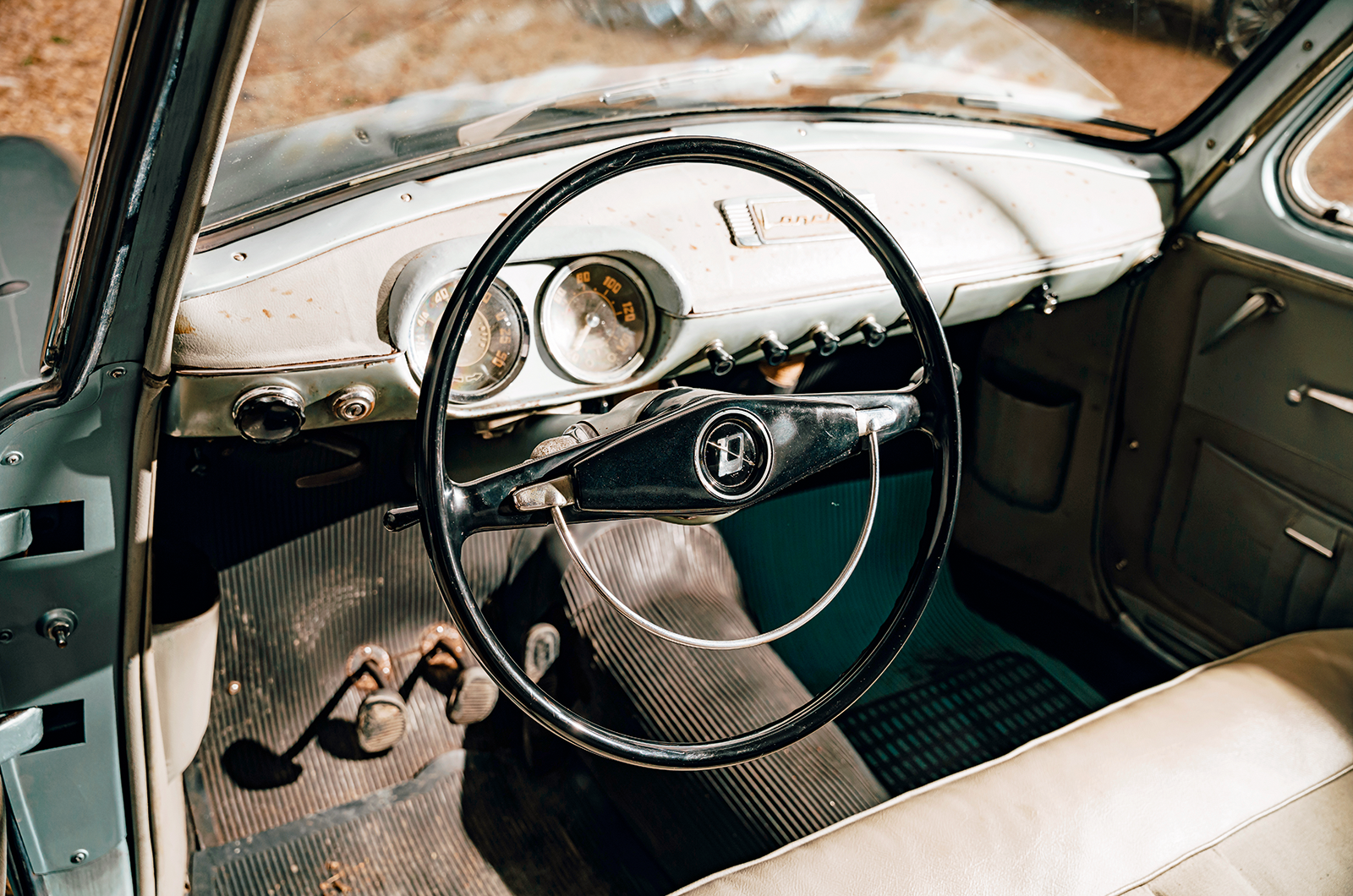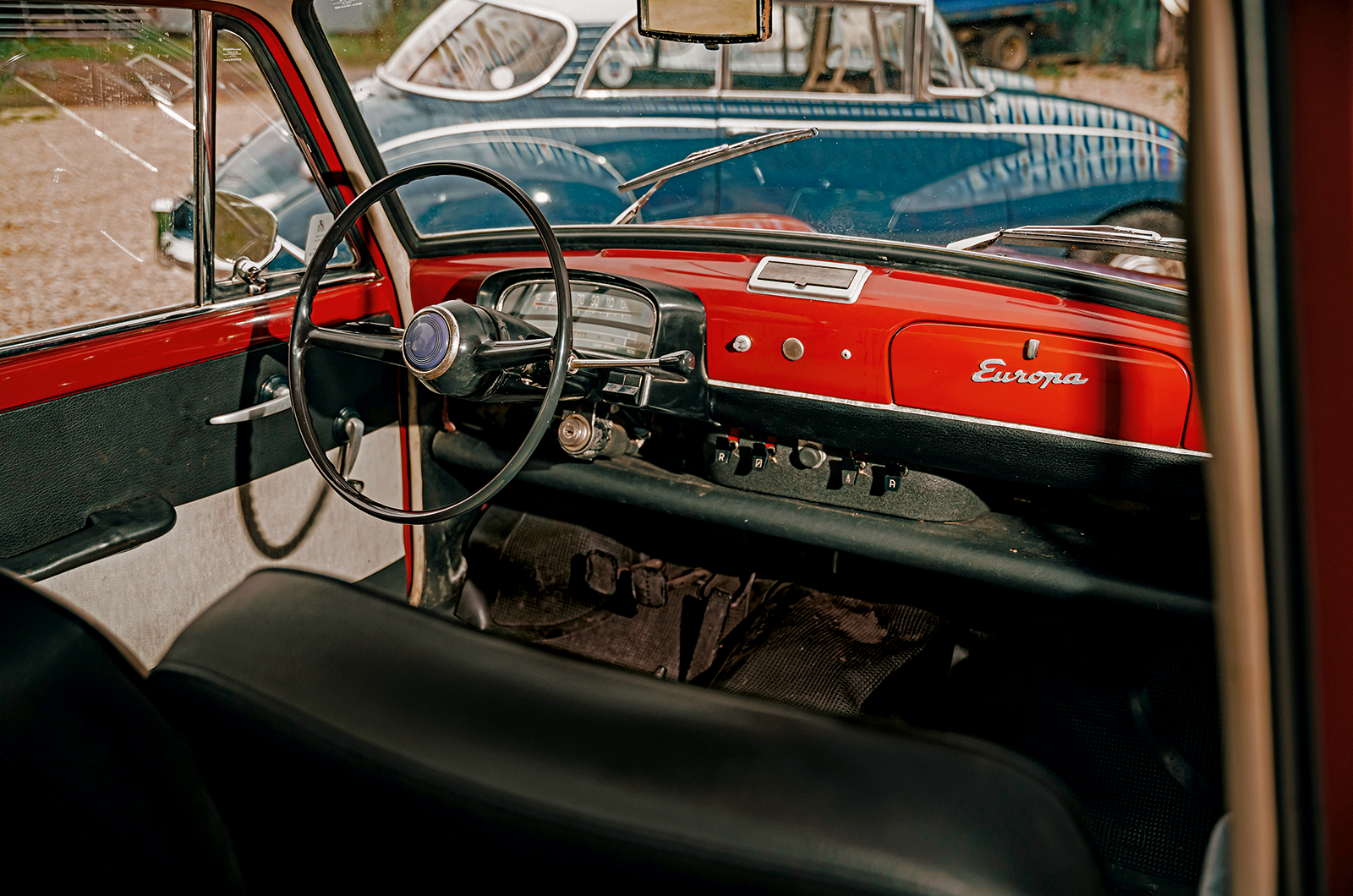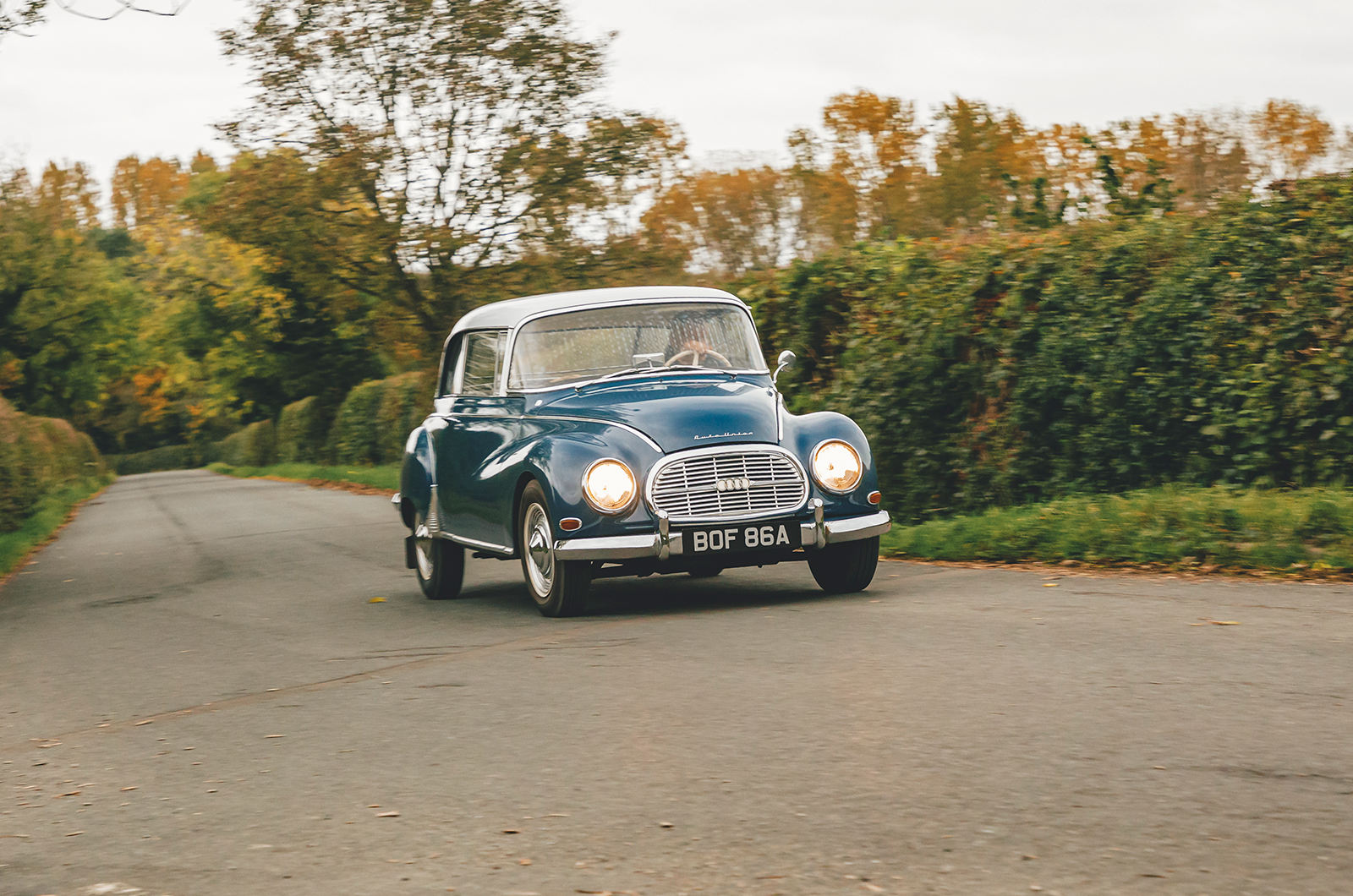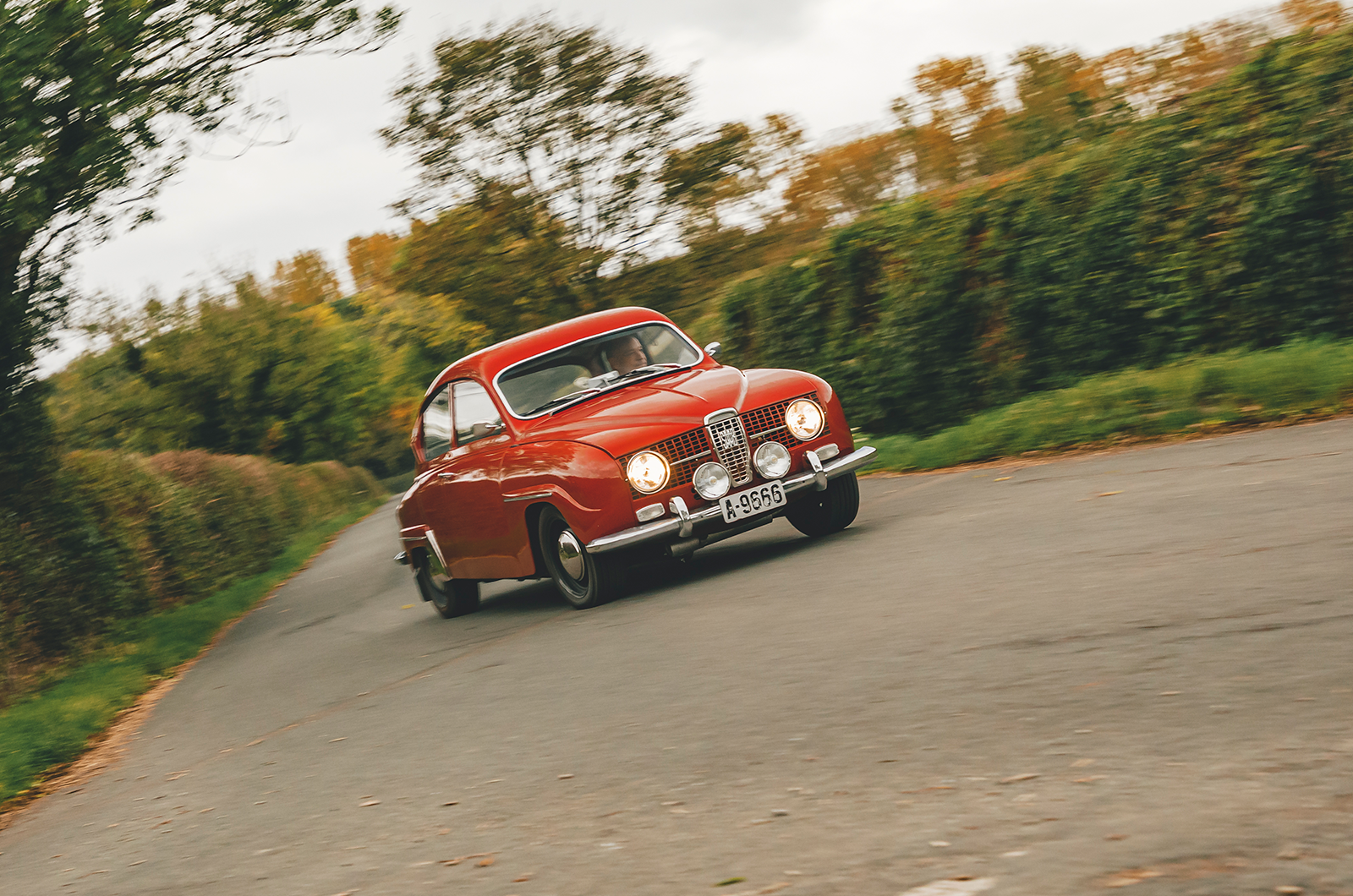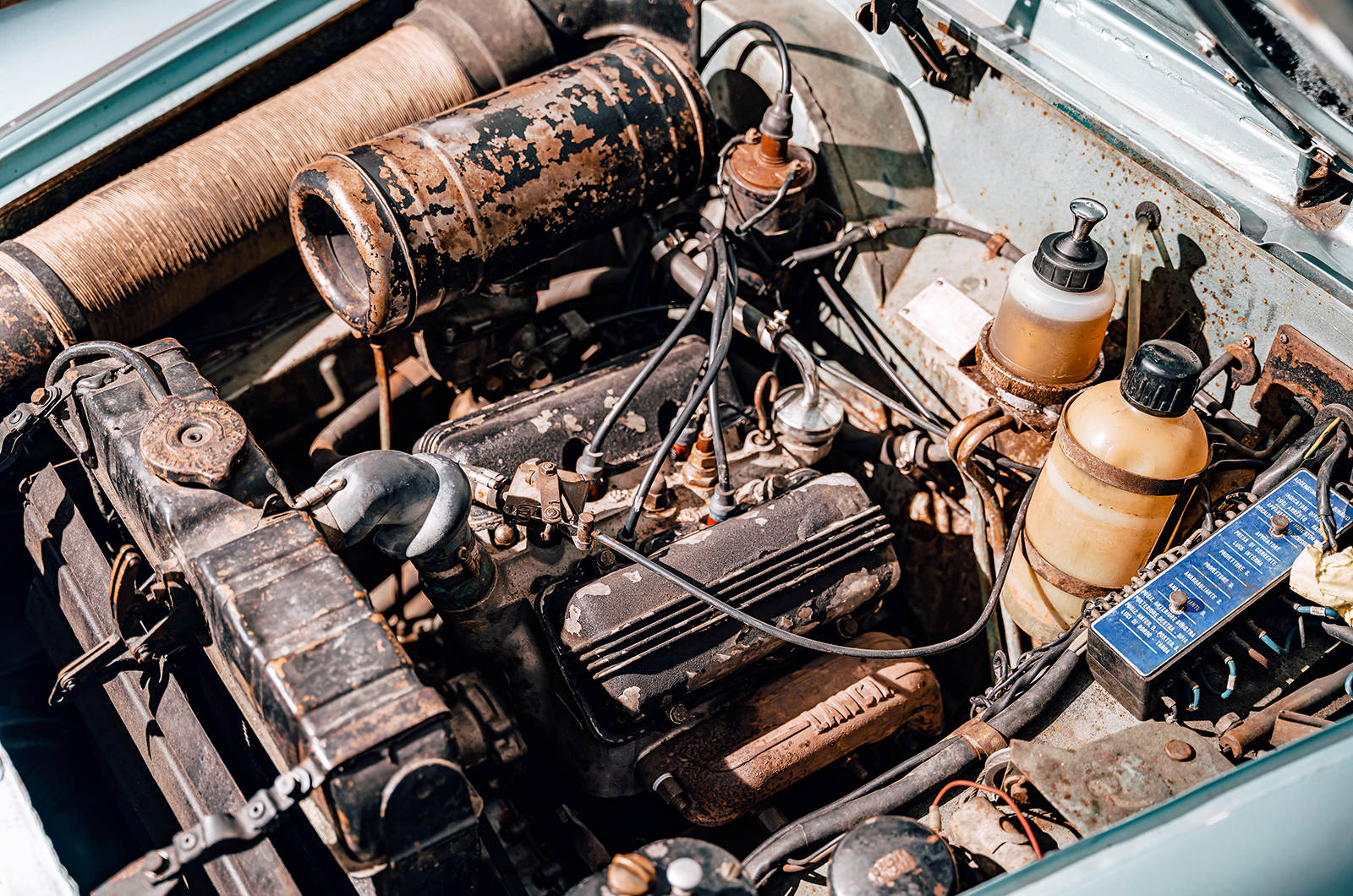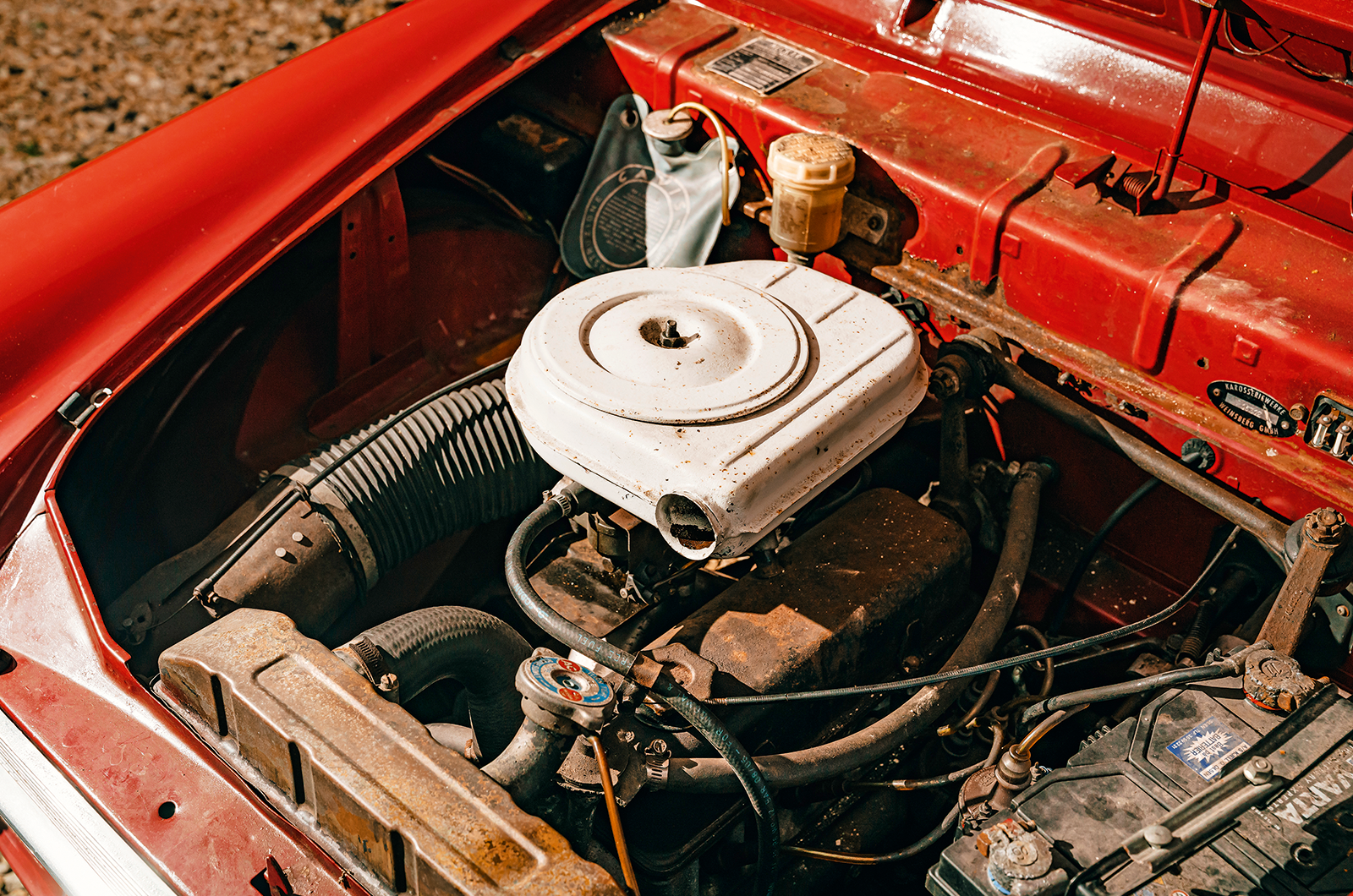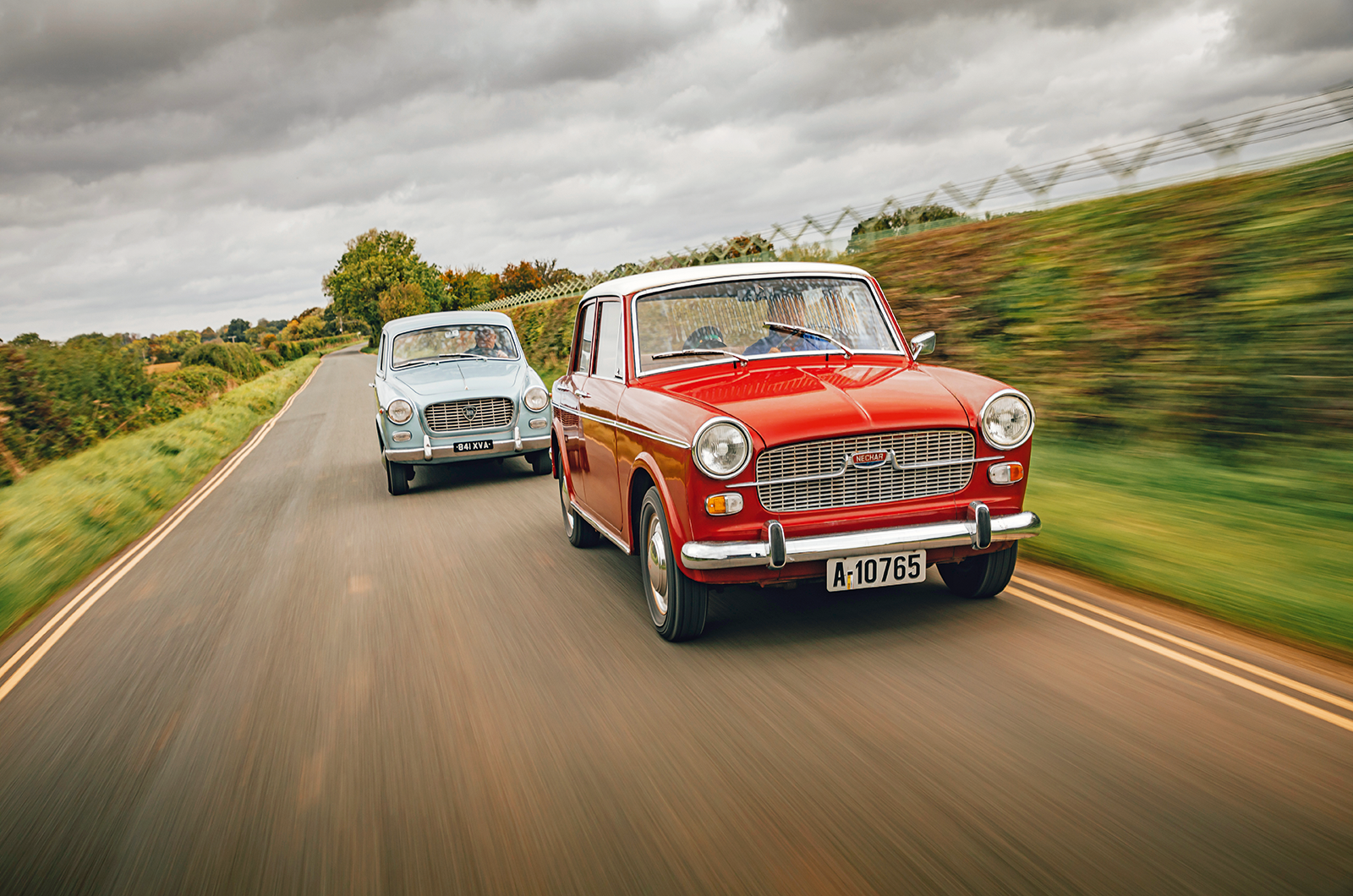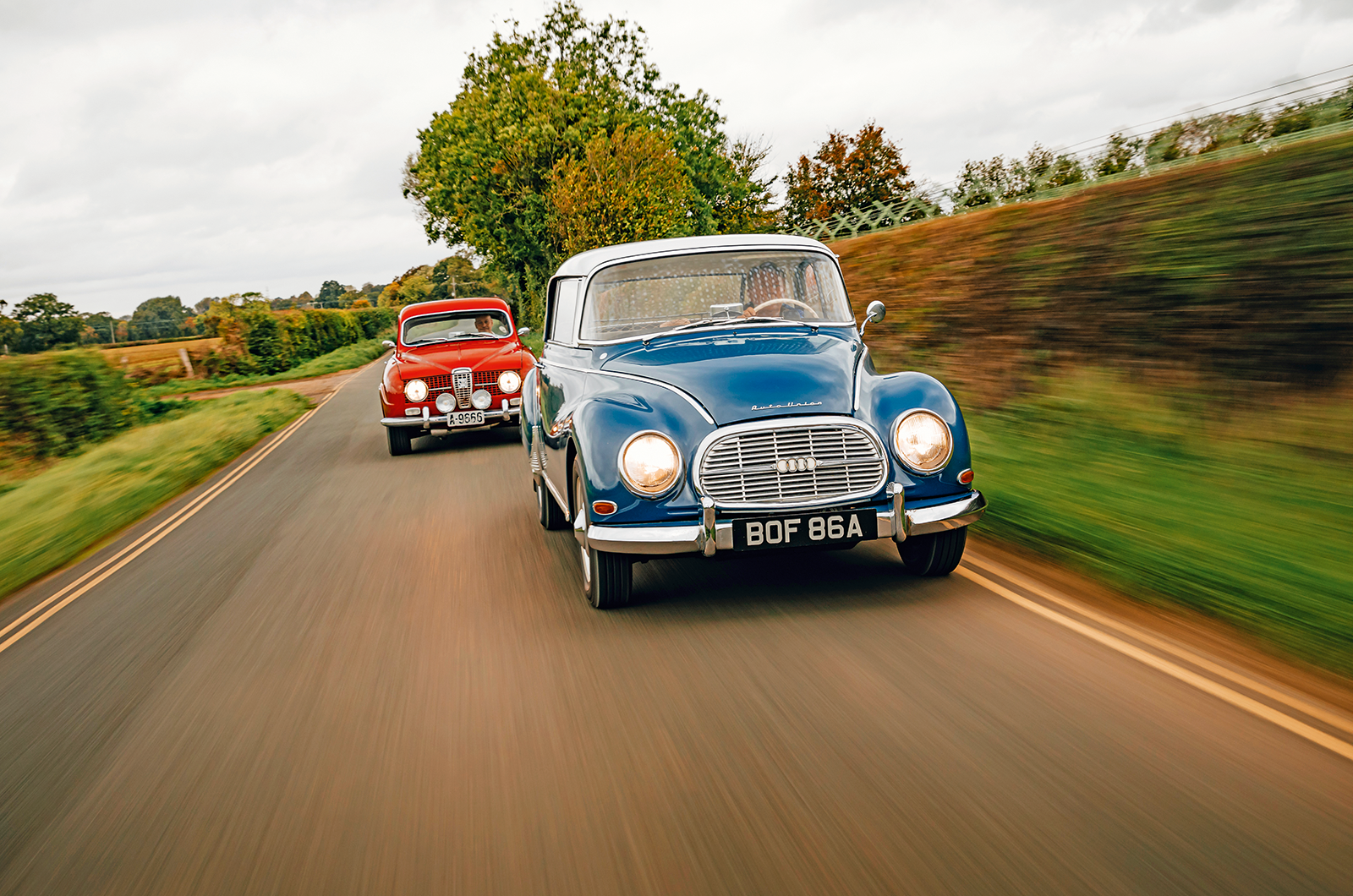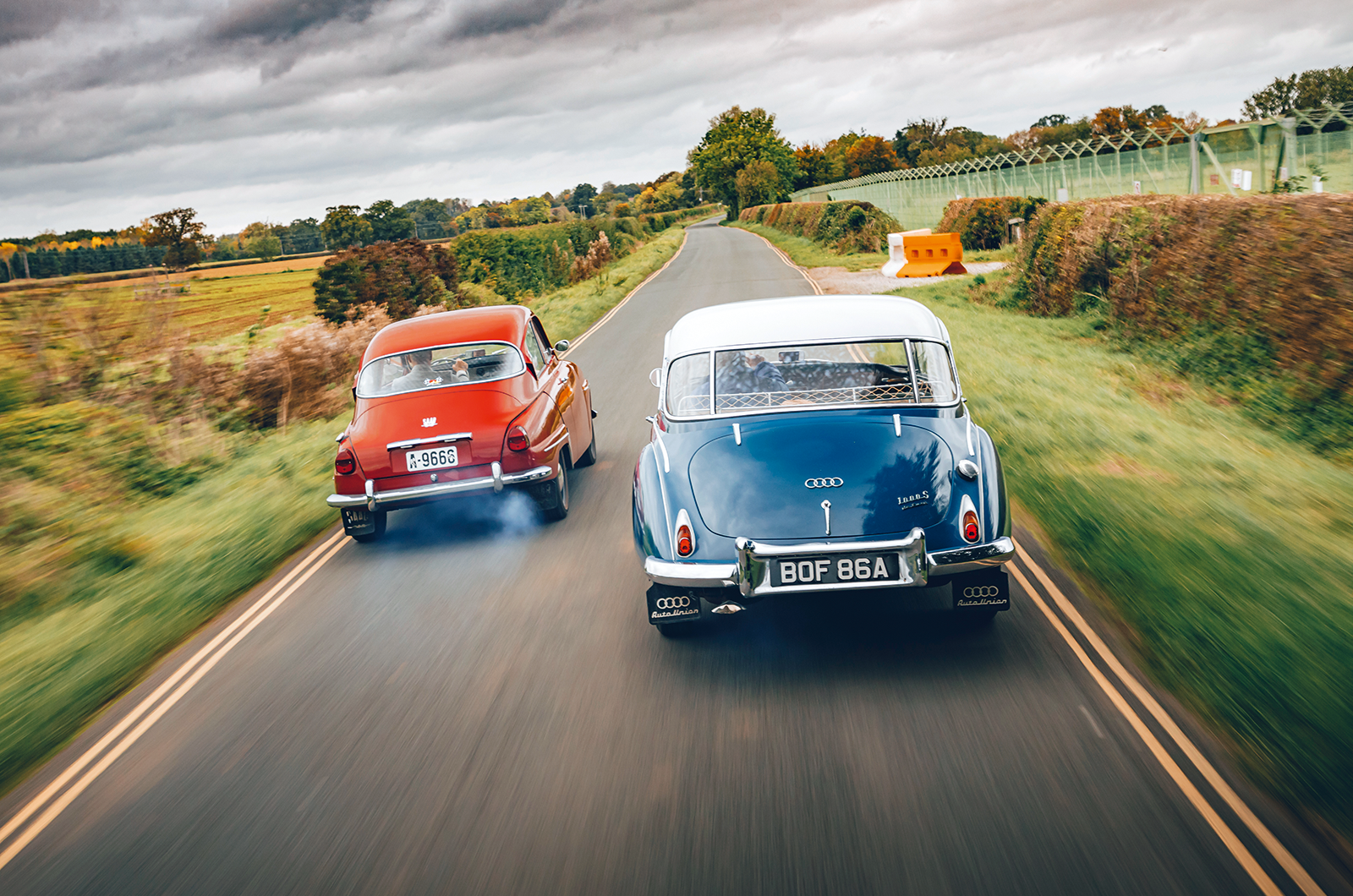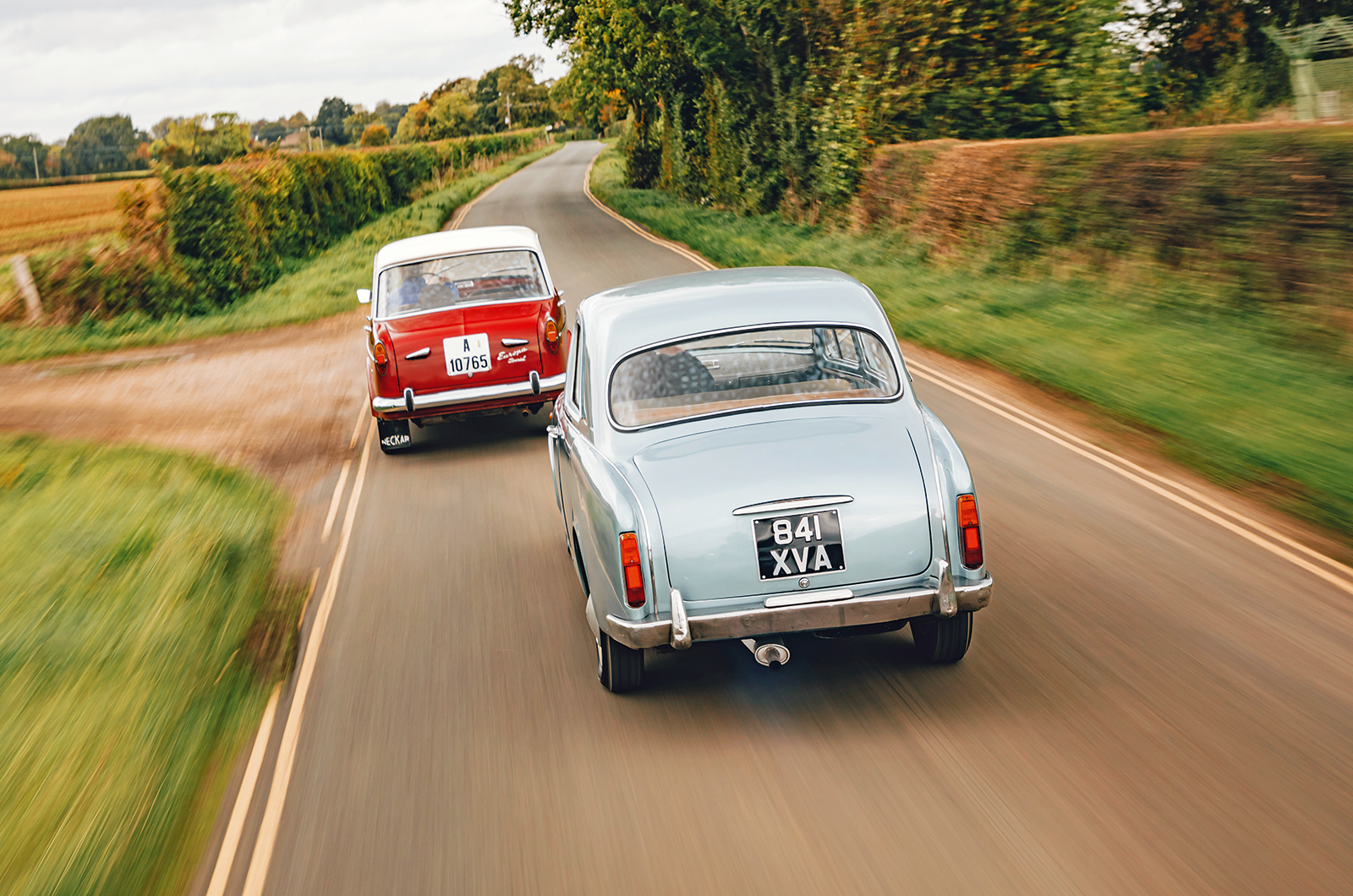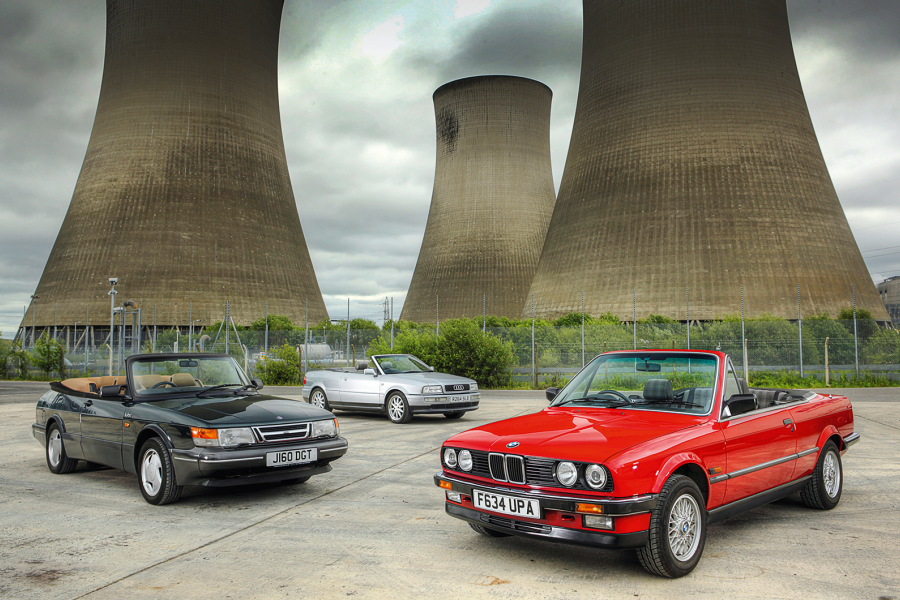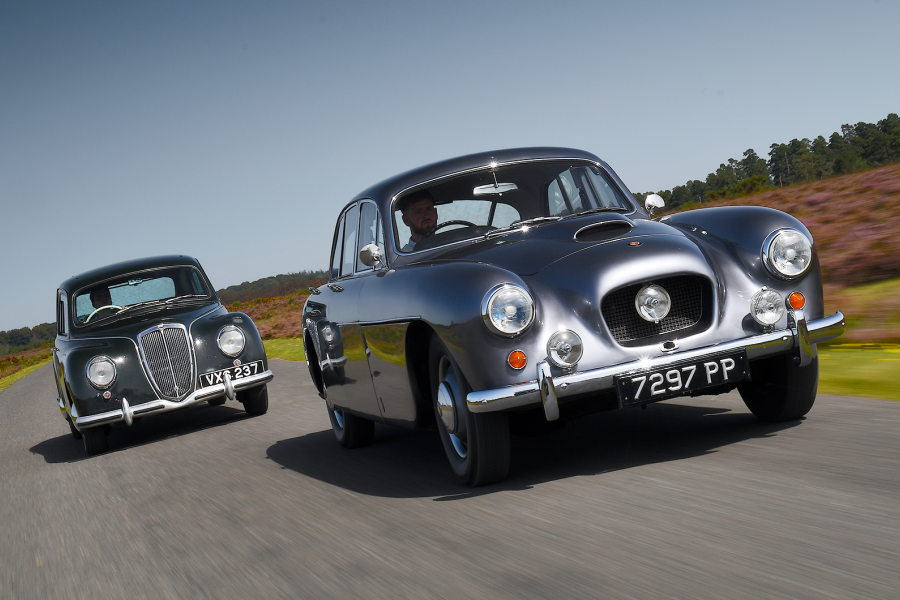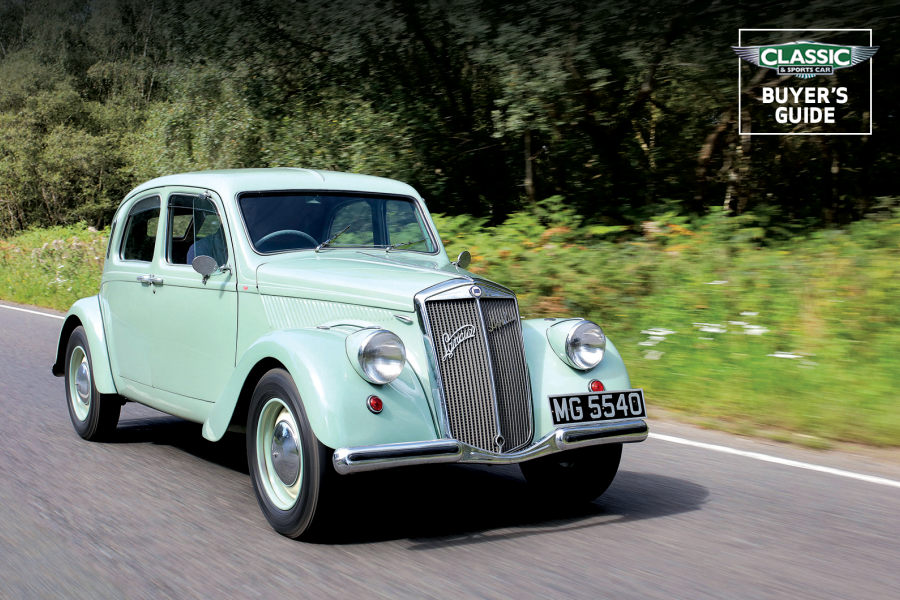It also has the most rear legroom, whereas the wider but less well-packaged Auto Union – with its thermometer speedo, fake wood, fat seats and that cream, egg-shaped steering wheel – is quite intimate in the rear.
It looks as if you might really crack your kneecap on the dogleg of its wraparound ’screen if you’re not careful, too.
The Fiat has the best column change, closely followed by the Lancia.
Neither requires any particular thought or effort as you whip the lever around the gate with total precision.
Engage the freewheel in the Auto Union (left) for clutchless downchanges; the Saab has hanging pedals
Not so the Auto Union, which, even after you have worked out that the gear positions are reversed (first below second, fourth above third), requires practice.
Like the Saab, it redeems itself to a certain extent in that, with its freewheel engaged, clutchless downchanges are possible, although you do lose engine braking.
Viewed from the outside (usually through a thin haze of oil smoke), the 96 doesn’t appear to be hustling down the road all that fast, even if it is emitting a shriek that could summon the ghost of Carlsson.
The ‘ring-a-ding-ding’ engine sounds of the two-strokes have a unique appeal, and it cannot be denied that they smooth out beautifully as the revs build, with the full benefit of those inherent six-pot firing impulses.
The narrow-angle Lancia V4
They are noisier and more hesitant at lower revs, where torque is lacking so you need to make free use of the gears – which in the Swedish car is less of a chore – to get them up to speed.
On the flat, both Saab and the Auto Union will cruise at 70mph-plus without strain, but not very economically: 25mpg from less than 1000cc doesn’t really compute in 2022, but excessive thirst was a perennial two-stroke issue – along with the nuisance of having to add oil to the fuel.
The Lancia, which is able to top 80mph and cruise at 75, should return at least 30mpg – maybe even 40, if driven gently.
Its engine, a neat square ‘box’ of a V4 with a single, common head for both banks of cylinders, has instant throttle response and no flat-spots.
The Fiat’s willing 1.1-litre ‘four’
There is every encouragement to drive it hard because it sounds so lusty and unburstable, but there is also ample torque available for when you are feeling lazy.
The Fiat’s three-bearing, in-line pushrod ‘four’, of pre-war origin, is not quite as refined as the Appia’s but equally as game, with really good pull from low revs in its relatively high top gear.
The Lancia’s intermediate ratios are closely bunched in true Alpine fashion, and the lack of slop in the mechanism, plus the neutrality of the handling, make it the most fun to drive.
There is modest body roll and ample grip combined with a ride that smooths out bumps quietly with no rattles from the beautifully contrived doors.
The Neckar/Fiat (front) goes well in a straight line, but struggles with understeer in corners
On a greasy roundabout you can tweak its tail at will, whereas the Fiat builds up quite strong understeer with steering that is vague compared with the other cars here.
The 1100’s live axle doesn’t need much provocation to start winding up and its brakes are not as authoritative as the Appia’s big drums, although they do improve upon the dead feel of the Auto Union’s set-up.
The Saab is a nifty, flat-cornering car that feels more naturally agile than the 1000S, which has rather heavy steering and a poor lock.
Both of these front-drivers are essentially stable, with slightly lively ride quality (improved by having passengers aboard) and useful ground clearance.
The Auto Union (front) and Saab are both very stable cars, although the latter is slightly more agile
At 20-plus seconds from 0-60mph, none of these baby Euro saloons will attract speeding tickets, but that’s not the point.
In each case they offer a strength of personality that transcends ideas of performance.
These are cars with strong national characteristics, vehicles you could attribute to a country of origin on sight – perhaps even by sound or smell – in a way that would be impossible with their 21st-century equivalents.
You soon come to like the Fiat for its cheerful, undemanding character: it’s a car designed first and foremost to be easy to drive, for the broadest possible appeal.
The Saab (left) tries to differentiate from the norm, while the Auto Union is a Mercedes-Benz wannabe
The Saab, in contrast, tries to do everything differently – even its door-glasses drop at a weird angle – but for those who take the time to know it well, the 96 will be rewarding.
The Auto Union really wants to be a baby Mercedes. It is a well-built car in that typically German way a Beetle owner would recognise, but is less successful than the Saab in hiding the shortcomings of two-stroke power and was very much yesterday’s car even in 1960.
There is something engagingly cheeky about the way the little Lancia looks and drives that stays in your head long after the pleasantries of the Fiat – and novelty of the two-strokes – has faded.
It has a solid quality that is way beyond the needs of this class of car, a reminder of Lancia’s penchant for doing things the hard way wherever possible.
“Nobody cared about ensuring pedestrians got a soft landing on a bonnet or pretended to have much interest in cleaning up smelly exhausts”
Like the others, the Appia is a product of a carefree age of small-car design when, with no particular pollution or crash-safety laws to worry about, the designers of these cars had a free hand to pursue the ideals and technologies that were intrinsic to their marque identities.
Nobody cared about ensuring pedestrians got a soft landing on a bonnet or pretended to have much interest in cleaning up smelly exhausts.
All the engineers of the ’50s had to do was concentrate on making cars that were adapted to the typography and taxation of local markets.
The result was a buffet of engineering novelty in the quest for small family saloon utopia.
Images: Max Edleston
Factfiles
Necktar Europa (Fiat 1100D)
- Sold/no built 1962-’66/408,997
- Construction steel unitary
- Engine iron-block, alloy-head, ohv 1089cc ‘four’, single Weber carburettor
- Max power 48bhp @ 4800rpm
- Max torque 58Ib ft @ 3000rpm
- Transmission four-speed manual, RWD
- Suspension at front wishbones, coils rear live axle, leaf springs; telescopic dampers f/r
- Steering worm and roller
- Brakes drums
- Length 12ft 10in (3912mm)
- Width 4ft 9in (1448mm)
- Height 4ft 11in (1498mm)
- Wheelbase 7ft 8in (2340mm)
- Weight 2060Ib (934kg)
- Mpg 29
- 0-60mph 21 secs
- Top speed 80mph
- Price new £800
- Price now £5000*
Lancia Appia Series 3
- Sold/no built 1953-’63/98,027 (all)
- Construction steel unitary
- Engine iron-block, alloy crankcase and head, ohv 1090cc V4, single Weber carburettor
- Max power 48bhp @ 5000rpm
- Max torque 63Ib ft @ 3000rpm
- Transmission four-speed manual, RWD
- Suspension at front sliding pillars, coils rear live axle, leaf springs; telescopic dampers f/r
- Steering worm and sector
- Brakes drums
- Length 13ft 2¼in (4020mm)
- Width 4ft 10in (1473mm)
- Height 4ft 9in (1448mm)
- Wheelbase 8ft 2¾in (2508mm)
- Weight 2028lb (920kg)
- Mpg 36
- 0-60mph 23.7 secs
- Top speed 82
- Price new £1587
- Price now £5-12,000*
Auto Union 1000S
- Sold/no built 1958-’63/171,008
- Construction steel chassis and body
- Engine iron-block, alloy-head, two-stroke 980cc triple, single carburettor
- Max power 50bhp @ 4000rpm
- Max torque 61Ib ft @ 2250rpm
- Transmission four-speed manual with freewheel, FWD
- Suspension transverse leaf springs, telescopic dampers f/r
- Steering rack and pinion
- Brakes drums
- Length 13ft 10in (4216mm)
- Width 5ft 6¾in (1694mm)
- Height 4ft 9¾in (1465mm)
- Wheelbase 7ft 8½in (2350mm)
- Weight 1974Ib (895kg)
- Mpg 28
- 0-60mph 23 secs
- Top speed 80mph
- Price new £1240
- Price now £5-12,000*
Saab 96
- Sold/no built 1960-’67/547,221 (all 96s)
- Construction steel unitary
- Engine iron-block, alloy-head, two-stroke 841cc triple, three carburettors
- Max power 55bhp @ 5000rpm
- Max torque 60Ib ft @ 3000rpm
- Transmission four-speed manual with freewheel, FWD
- Suspension at front wishbones rear beam axle, trailing arms; coil springs, telescopics f/r
- Steering rack and pinion
- Brakes discs front, drums rear
- Length 13ft 8¼in (4172mm)
- Width 5ft 2¼in (1580mm)
- Height 4ft 9¼in (1454mm)
- Wheelbase 8ft 2¼in (2495mm)
- Weight 1800Ib (816kg)
- Mpg 27
- 0-60mph 19 secs
- Top speed 90mph
- Price new £1058
- Price now £5-12,000*
*Prices correct at date of original publication
READ MORE
Saab 99: when brains beat brawn
Quality street: Riley One-Point-Five vs Lancia Appia
Separated at birth: Volkswagen K70 vs NSU Ro80
Martin Buckley
Senior Contributor, Classic & Sports Car
